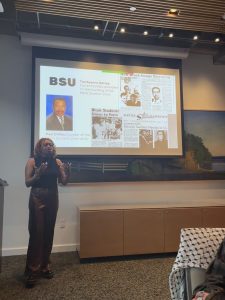Seattle University prides itself as a diverse institution, being the first university in Washington state to fully divest from fossil fuels and living by values that empower students to be meaningful agents of change. While these are only a few accomplishments that exist within the university’s foundation, Seattle U’s progressive nature may be the reason some current students who have a drive for social justice decided to attend here. However, one may ask, what narratives accompany those achievements, and who led such efforts?
With the objective to educate, Sustainable Student Action (SSA), Black Student Union (BSU) and Seattle University’s Students for Justice In Palestine (SUSJP) hosted a “History of Student Activism” event to engage current students in understanding who shaped our university.
“SU students made big changes in the past, and we can do it again. Sometimes it can feel like the barriers we are faced with as student activists are impossible to break down, but that’s not true,” Alice Gilson, a third-year environmental studies major and SSA member, wrote in an email to The Spectator. “Many of the challenges that student activists faced 10, 20, 30, even 50 years ago, are the same as the ones we are dealing with now. This is why it’s so important to archive that information and learn from it, it helps us organize, and it helps inspire us to keep going.”
The program was split into various parts, with alumnus Robert Gavino leading the first portion discussing the Matteo Ricci College (MRC) sit-in. Back in 2016, when multiple students within the college began to realize they were having similar negative experiences with MRC, students formed an MRC student coalition. Attempts were made to directly discuss with the administration instances of experienced racism and dissatisfaction with the curriculum. However, after various unsuccessful meetings, students, including Gavino, lined stairways and slept on floors in the College of Arts and Sciences (CAS). Chants of “A racist institution cannot be our solution! We need an education that leads to liberation,” echoed throughout the Casey building during the sit-in.

Requested changes became formal demands, including but not limited to a non-eurocentric interdisciplinary curriculum and the requirement that every staff member in MRC undergo training from an anti-racist network in Seattle. After 26 days, students were met with cooperation; MRC agreed to revise their curriculum, and former Dean Jodi Kelly would retire.
However, there was an additional response from the university that was of a bureaucratic nature. Gavino explained that the MRC sit-in was one of the largest and most publicized protests Seattle U had seen and to prevent something of a similar nature from occurring again, the On-Campus Demonstration Policy was created. They noted how that the policy was oppressive during their time at Seattle U, preventing Gavino and other students from holding a demonstration in response to Trump winning the election in 2016. Many students appeared surprised to learn that this policy was created in response to the protest, especially considering how it acted as a roadblock for SUSJP last year when they were planning rallies throughout the year calling on the Seattle U community to stand in solidarity with Palestine.
Téa’Ayanna Garvey, a fourth-year anthropology major and president of BSU, led the second part of the program and gave a brief history of how BSU came to exist. Along with highlighting BSU Founder Paul Chiles, Garvey also discussed the importance of Seattle U’s first Rhodes Scholar Emile Wilson and the first director of the Office of Minority Affairs (OMA), now known as MOSAIC, Charles H. Mitchell.
When BSU was formed in 1968, it was largely in response to student civil rights unrest. Its formation gave students of color an increased ability to advocate for their needs. Chiles in particular approached the university, appealing to the Jesuit nature, and demanded that there be more Black professors and students as well as more offerings of courses centered around Black history and thought. His efforts are what influenced the creation of Seattle U’s African and African American Studies Program.
In conjunction with the creation of BSU, OMA was formed to provide academic support services for students of color, specifically offering tutors and English support programs. Similarly to Chiles, Mitchell was another advocate for adding ethnic courses to the university’s core curriculum.
When Garvey began conducting her research, she quickly realized that the lack of documentation within BSU and the university would pose a challenge. She mainly depended on archives from The Spectator and The Seattle Times as scouring online and Seattle U’s website proved ineffective. Notably, Garvey was shocked when she found that there was no mention of Mitchell’s history at Seattle U on his Wikipedia page. One can find that he was the president of Seattle Central Community College and a professional American football player, but no mention of being the first director of OMA.
Part of the reason why Garvey focused on the earlier legacy of BSU is because of lacking archival records. Though she feels inspired to improve how students can access the history of her club, even considering the idea of BSU eventually creating a documentary, Garvey wants there to be a level of support at the institutional level to better document the stories of all student organizations.
“I wish that we had more transparency about how the university truly feels about their diversity efforts,” Garvey said, noting how the university uses their diversity statistics as performative activism. “When it comes to protecting minority students that are here, it comes with documenting the history and making sure that we have the formal institutional ability to learn about that history.”
The third part of the program was led by alumni and previous SSA members Molly Mattingly and Nicolas Cruz who discussed the process of Seattle U divesting from fossil fuels. Efforts led by SSA began as early as 2012, with a formal petition circulating by winter of 2013 and a formal request being made in the fall of that year. Seattle U administration initially responded with a firm no, saying that there would never be a conversation about divestment, but students refused to accept their stance. A rally and additional petition immediately followed, telling the university “We Remain Committed.” From then until 2018, SSA and faculty in support continued to pressure the administration until collective effort led the Seattle U Board of Trustees to vote to divest the endowment from fossil fuels. As of June last year, the university is fully divested.
The final part of the event was led by Aoife Kennedy, a fourth-year environmental studies major, SSA member and SJP executive board member. Kennedy discussed The Participator, an alternative student paper that ran for two issues in 2008 with the beginning of a third issue that lives in the inboxes of its writers to this day. In response to the perceived inadequate reporting style of The Spectator at the time, the students writing for The Participator were dissatisfied with the neutrality of the paper, feeling as though stories were merely a summary of events rather than posing critical discussion of issues and events.
Kennedy talked about the difference in coverage of the same stories between The Spectator and The Participator, specifically the Opus Prize Extravaganza. What The Spectator celebrated as a success, The Participator criticized for its performative nature, characterizing the event as having a similar vibe to the charity elicited from trips American students take to third-world countries to volunteer. Especially in regard to how The Spectator covered this event, they were simply viewed as a tool of the institution as opposed to students writing stories that could spark meaningful conversations.
Though The Participator was formed in response to disappointment with The Spectator’s reporting, there were larger socio-political issues occurring at the time that Kennedy discussed as being an additional factor. Students were responding to national anti-immigrant sentiments and when Seattle U invited the Immigration and Customs Enforcement to a criminal justice career fair, there was a perceived necessity for another outlet for students to voice their concerns and contradictions with the university aside from protest.
However, there is one more reason for The Participator’s formation, and it was the desire to dig up the history of student activism they felt had been continuously inaccessible.
“We know the story of our university through the lens of our institution and how they want to tell that story [but] the story of student activists is the story of our university through a different lens,” Kennedy said. “Through the lens of those who are marginalized and through the lens of our social justice mission and the people who are actually trying to be actionable.”
Kennedy views SSA’s event as a stepping stone towards what could potentially become a series of conversations surrounding the history of student activism. The four-year cycle makes it difficult for students to carry forth momentum, especially in movements that clubs like SSA advocate for. Maintaining awareness among new students that come to Seattle U, SSA and other student organizations with similar values of social justice can keep the fires of student activism burning.














